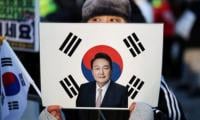The economy under the PTI
When it comes to the PTI’s economic performance, discussions tend to be one sided (either for or against). In a recent article in these pages, Mohammed Zubair (‘The two-year scorecard’, July 19), ignored his own party’s faults during 2013-2018.
For example, while decrying the growth in public debt under the PTI, he did not mention the fact that a major portion of accrued debt was used to repay debt accrued under the PPP and PML-N. Further, the fall in GDP is strongly correlated with a fall in trade deficit, which had risen to a historical high of more than $50 billion, partly due to Ishaq Dar’s insistence to keep the rupee to dollar parity at Rs100. As the PTI rightly took steps to reduce the deficit, a fall in GDP was expected, made worse by Covid-19.
For me, the PTI government’s major weakness was its unrealistic proclamations before coming to power, assuring the people that it had a set program of reforms and a capable team ready to set the economic direction right. Two years down the line, it’s clear that they neither had a team nor a program. In promising outlandish and unrealistic scenarios, the PTI dug itself a hole from which it will be difficult to come out till it remains in power.
Most of what the PTI’s economic team has done till now is what all economic dispensations have been doing before them: day-to-day firefighting.
Economic management in these two years has been influenced by ‘imported’ ideas. Two failed ventures – the chicken breeding program for poverty alleviation and ‘Sarmaya-e-Pakistan’ – amply reflect this fact. The former was inspired by Bill Gates’ advocacy, while the latter was inspired by the Malaysian success in turning around its loss-making public entities. In the case of chicken breeding, the ground realities suggest that breeding chicken at home has long been given up, even in rural areas. If it were such a potent weapon in poverty alleviation, nobody (especially in rural areas) would have given up on it. Yet, against all the evidence, the program was launched with much fanfare. Today, it’s rare to even hear about it even from the government’s overzealous PR spokespersons.
Similarly, the sarmaya concept was doomed from the very start because Pakistan and its public-sector entities are quite different from Malaysia. Expecting that the entrenched interests would give up so easily turning them around was nothing but naivety. In this exercise, no lesson was learned from previous such exercises and why they remained futile? The PSEs still bleed fiscally, more than ever. By now, the ‘sarmaya’ company is only a name.
Another case of mindlessly diving into the unknown without taking into consideration ground realities is the case of special economic zones (SEZs). In the zest to create newer SEZs, no consideration whatsoever was given to the issues plaguing the already established one’s (like under-utilization of resources and service provision issues). If the already established SEZs are finding it difficult to operate, what logic is there to establish new ones?
The touchy issue of inflation remained unmanaged, and has been a continuous blot on the PTI’s economic team’s performance. Here, the fault lies in poor understanding of the value chains that underpin working of the different sector sectors of the economy (like food production and distribution and oil supply). Raising interest rates only exacerbated the situation because it was never a demand side phenomenon but supply side issues that made it worse.
And of course, like its predecessors, Khan’s government has never given serious thought to two fundamental but largely ignored causes of Pakistan’s economic malaise: its continuously rising population and low overall productivity in almost every sector of the economy. The former applies a seriously crushing pressure on already dilapidated state of service provision and increases carbon footprint, while a worrying implication of the latter is that an ‘agrarian’ country like Pakistan now has to import large quantities of food items.
Last, but not the least, while the PM is on the lookout for ‘out-of-the-box’ solutions, his economic management relies on tried and tested septuagenarians and an advisor who has little (if any) stake in Pakistan.
In between, there were instances which deserve credit and praise. I will start with CPEC, arguably the most important project in Pakistan’s present circumstances. A lot hinges upon the outcome of this program in terms of Pakistan’s future economic outcomes. The government has rightly turned its focus to the socio-economic, agricultural and scientific cooperation aspects in its Phase-II compared to the PML-N’s unhealthy obsession with infrastructure in its first phase (one outcome of which was the various expensive power production plants). Especially important in this regard would be the long-term plan for agriculture, which desperately needs technological upgradation if Pakistan is to ward off serious food shortages in the future. Additionally, the formation of a committee to renegotiate expensive power contracts is indeed a step in the right direction.
Second, Khan’s government is very rightly insisting upon transferring fiscal powers to the district/union council level rather than remaining with provincial capitals. If this can be achieved, it would be a real game-changer as far as productive fiscal outcomes are concerned. The present working of provincial capitals in fiscal matters induces the same problems as were once associated with an all-powerful Islamabad.
Third, this government seems to be making a determined effort to boost trade with neighbours and beyond. It is increased trade, rather than enmity, that will be Pakistan’s saviour in the future and produce millions of job opportunities within the country. Pakistan’s rapprochement with Afghanistan, Iran and Bangladesh is a good example of these initiatives. It is quite heartening to watch the beginnings of transit trade between Afghanistan and India through Wagah, heralding a new chapter in Pakistan’s history. Fourth, the way the current government has exposed the wheat and sugar subsidy scams (despite some of its own members coming under scrutiny) is definitely praiseworthy. The aspect of praiseworthiness takes on added significance given that previous governments went through futile exercises in the name of inquiry committees, with no result. Not only have these reports exposed the modus operandi of the crime committed, but could go a long way in ensuring that taxpayer financed subsidies are spent efficiently in the future, and for a public purpose.
And fifth, there have been administrative measures that can go a long way in righting the wrongs with a rusty, inefficient public-sector working. For example, the unethical practice of departments keeping an allotted budget in the savings accounts and then a few officers pocketing the money has been put to an end (though the money has not been recovered. Also note that this unethical practice was pointed out by a domestic source, not by big-time donors). Similarly, the changes in laws to weed out inefficient officers from service, if applied properly, will ensure a better level of public service and its delivery.
Overall, the negatives do outweigh the positives as far as managing the economy is concerned. It’s a long debate, with some leading facets pointed out in the lines above. Suffice to state that the PTI, and Pakistan, have still got a long way to go.
The writer is an economist, working as a research fellow at PIDE.
Email: shahid.mohmand@gmail. com
Twitter: @ShahidMohmand79
-
 Prince William Makes Clear The Conditions He Has For Meeting Prince Harry
Prince William Makes Clear The Conditions He Has For Meeting Prince Harry -
 Sara Foster Slams Age Gap Relationship After 'blah' George Clooney Date
Sara Foster Slams Age Gap Relationship After 'blah' George Clooney Date -
 Jennifer Garner Recalls Enduring Ben Affleck’s Intense Beyoncé ‘Halo’ Phase
Jennifer Garner Recalls Enduring Ben Affleck’s Intense Beyoncé ‘Halo’ Phase -
 Prince Harry’s Mental Health Ends Up At Stake As Meghan Moves Him To 'second Fiddle'
Prince Harry’s Mental Health Ends Up At Stake As Meghan Moves Him To 'second Fiddle' -
 Bradley Cooper On Who His Mother Thinks Is The World’s Best Actor
Bradley Cooper On Who His Mother Thinks Is The World’s Best Actor -
 Meghan Markle Offers Glimpse Into Intimate Dance Moment With Harry Amid Split Rumors
Meghan Markle Offers Glimpse Into Intimate Dance Moment With Harry Amid Split Rumors -
 Jon Bon Jovi Joins The Viral 2016 Throwback Trend With Nostalgic Photos
Jon Bon Jovi Joins The Viral 2016 Throwback Trend With Nostalgic Photos -
 Kate Middleton Hailed For Her Lack Of ‘obligation’ As Well As Altruistic, Selfless Qualities
Kate Middleton Hailed For Her Lack Of ‘obligation’ As Well As Altruistic, Selfless Qualities -
 Jason Momoa Says Being With Beau Adria Arjona Feels 'perfect'
Jason Momoa Says Being With Beau Adria Arjona Feels 'perfect' -
 Idris Elba Says One Mix-up Nearly Cost Him A Knighthood From King Charles
Idris Elba Says One Mix-up Nearly Cost Him A Knighthood From King Charles -
 Andrew Mountbatten Windsor Incurs Anger Of Biggest Royal
Andrew Mountbatten Windsor Incurs Anger Of Biggest Royal -
 Megan Fox, Machine Gun Kelly's Relationship 'is Just About Co-parenting'
Megan Fox, Machine Gun Kelly's Relationship 'is Just About Co-parenting' -
 Prince Harry, Meghan Markle Warned They Can’t Fool Brits Because It Won’t Land
Prince Harry, Meghan Markle Warned They Can’t Fool Brits Because It Won’t Land -
 South Korea’s Ex-president Yoon Suk Yeol, Sentenced To 5 Years In Prison: Key Details Explained
South Korea’s Ex-president Yoon Suk Yeol, Sentenced To 5 Years In Prison: Key Details Explained -
 Princess Beatrice Is ‘terrified’ Of Mom Fergie: ‘She’s Begging Her To Not Destroy Her Future’
Princess Beatrice Is ‘terrified’ Of Mom Fergie: ‘She’s Begging Her To Not Destroy Her Future’ -
 Harry Styles’ New Album Earns Subtle Nod From Zoe Kravitz’s Dad
Harry Styles’ New Album Earns Subtle Nod From Zoe Kravitz’s Dad



